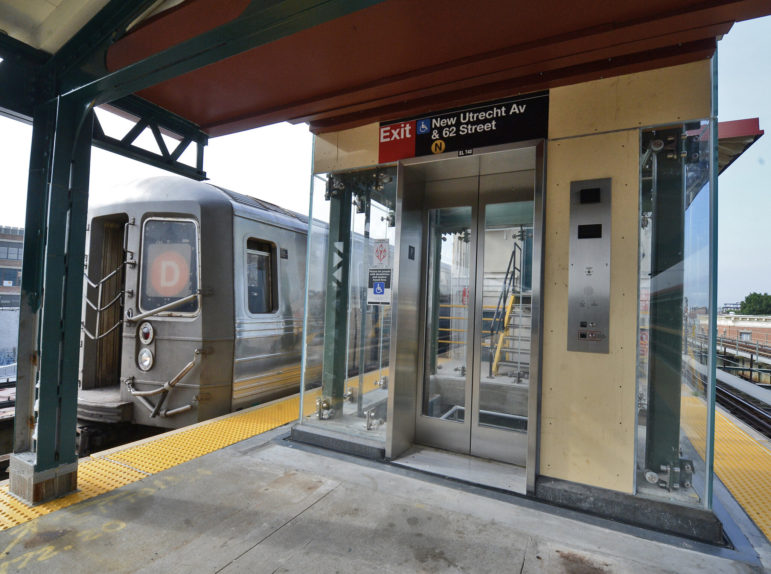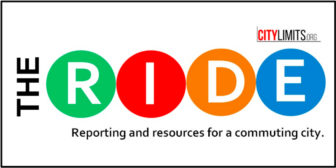
MTA
A new elevator at the New Utrecht Av/62 St (D,N) station. The capital plan aims to increase accessibility at dozens of stations.
The five-year, $51.5 billion capital plan approved by the Metropolitan Transportation Authority’s board on Wednesday is the largest in MTA history—some $18 billion larger than its previous plan. It promises to fund new signals on 11 subway lines, add nearly 2,000 new subway cars, create a few new stations and make dozens of them more accessible as well as launch the next phase of the Second Avenue Subway.
On Wednesday’s Max & Murphy Show on WBAI, Manhattan Institute transit analyst Nicole Gelinas hailed the arrival of an on-time capital plan (the previous one was more than a year late) that is “fairer to New York City.”
“Since we started building things in 2000 [the city has] only gotten about half of capital money for expansion. This time around the city is getting about 78 percent of the money in the capital plan,” she said. What’s more, this plan is “putting significant money behind a new subway signal system,” Gelinas said. “That’s one of the most important things, probably the most important.”
The fact that transit chief Andy Byford is happy about the plan is “a good sign,” Gelinas added, and the promise to make 70 subway stations more accessible to people with mobility impairments not only helps thousands who use wheelchairs, walkers or canes but also “opens up the system to people who have baby carriages, people who have suitcases, children, people who can’t walk very fast.”
But for all its positives, the plan doesn’t answer all the questions facing the MTA over its finances or ability to achieve its ambitions.
Financing for the capital plan depends partly on congestion pricing—a system that has yet to be fully designed—generating enough money for the MTA to service the bonds it plans to secure with that revenue. Built into the capital plan is also a hope for federal funding, which could float or sink depending on national politics and the U.S. economy. And there’s a gap that the MTA will need to fill using regular bonds, which could be a tough lift given the hefty debt load the agency already carries.
Another question is whether the MTA can spend the money it finds. “It’s a little bit of a myth that the MTA says, ‘We’re going to invest $51.5 billion over the next five years,'” Gelinas said. “They’ve proven over and over that they really can’t make this work in five years.” The current capital plan, which covered 2014 through 2019, totalled $33 billion. “Of that,” Gelinas said, “they’ve only spent about $13 billion.”
Then there are the operational realties. Adding new trains and stations is great but it then requires additional, ongoing funding to operate all that new equipment, Gelinas noted. And while the capital work is under way, service is temporarily likely to get worse, not better. “Unfortunately, if we’re going to modernize, we will see a lot more weekend and night time shut downs.”
(With reporting by Xavier Means)
Hear our conversation with Gelinas below, or listen to the full program, which includes an interview with Stanley Fritz of Citizen Action NY about the debate over fusion voting:









3 thoughts on “The Good News and Big Questions in the MTA’s Very, Very Big Capital Plan”
Re: The Good News and Big Questions in the MTA’s Very Very Big Capital Plan. How real is the MTA funding plan to support the $51 billion 2020 – 2024 Five Year Capital Plan just passed by the MTA Board this past Wednesday? It is dependent upon taxes and fees including Real Estate Transfer and Internet Sales Tax along with Congestion Price Tolling which combined equal $25 billion plus $10.7 billion in anticipated Federal Transit Administration funding. There is no guarantee of FTA providing up to $3.5 billion in New Starts funding for the Second Avenue Subway Phase 2 costing almost $7 billion.
In April, the MTA claimed a potential savings between $500 million to a $1 billion for this project. This would have reduced the cost from $6 to $5 billion. Promised savings were based upon reduction in excavation for the 125th Street Station and building the 116th Street Station in space no longer needed for other work.
Under the $51 billion 2020 – 2024 Five Year Capital Plan, the cost increased by almost $1 billion raising the price tag closer to $7 billion. The previous federal share of $2 billion (33%) now assumes an amount which could end up $3.5 billion (50%) by the time the next cost estimate update becomes public. No one has come forward to explain these changes.
Second Avenue Subway Phase 2 is competing against the $12 billion no frills Gateway Tunnel project which is also looking for $6 billion from the same federal funding source. The full Gateway Tunnel project cost $29 billion. The odds of both securing FTA Full Funding Grant Agreements are the same as the Yankees playing the Mets in the 2020 Fall Subway World Series. FTA funding both in 2020 would leave little for many other proposed New Starts projects around the nation.
Congestion Pricing does not kick in until January 2021 or the second year of a five year capital program. The final details of who will pay what have yet to be worked out. What is the implementation schedule for installation of electronic tolling equipment? Elected officials behind the scene continue lobbying for exemptions. The MTA may not be able to count on all $15 billion in congestion pricing funding. A downturn in the economy could also result in less revenue from the Real Estate Transfer tax. There is a surplus of unsold Manhattan luxury apartments with even more coming on the market. How will the Internet Sales tax be collected? Many will avoid this by having family and friends in neighboring states do the purchasing. There are other MTA tax income sources impacted by the economy.
Is it realistic to expect Albany to provide $3 billion in new direct aid given the state still owes $7.3 billion in support for the current MTA for the 2015-2019 plan? The same is true for City Hall providing $3 billion who still owes $1.8 billion in support as well. The plan assumes the MTA will borrow another $10 billion in new debt. How much will this increase the MTA’s debt service payments? Even without including this new borrowing, the MTA forecasts that its debt will increase 31% by 2023 and will cost $3.5 billion or more annually. The MTA could easily end up with a shortfall in the billions.
There are other higher priorities than the $7 billion Second Avenue Subway Phase 2 project, Why not postpone this project until the 2025 – 2029 Five Year Capital Plan? Use the balance of $3.5 billion in unspent local funds designated for this project instead to accelerate bringing more subway stations up to a state of good repair and into compliance with ADA by adding elevators.
Stop wasting millions on transportation feasibility studies for future system expansion projects that will never happen in our life time. Do not initiate any new system expansion projects until each operating agency, NYC Transit bus and subway, MTA bus, Long Island Rail Road and Metro North Rail Road have reached a state of good repair for existing fleet, stations, elevators, escalators, signals, interlockings, track, power, vent plants, yards and shops.
This should also include insuring a majority of subway and commuter rail stations are in compliance with the Americans With Disabilities (ADA) Act. Ensure that maintenance programs for all operating agencies assets are fully funded and completed on time to ensure riders safe uninterrupted reliable service.
(Larry Penner is a transportation historian, writer and advocate who previously worked 31 years for the United States Department of Transportation Federal Transit Administration Region 2 New York Office. This included the development, review, approval and oversight for billions in capital projects and programs for the MTA, NYC Transit, Long Island Rail Road, Metro North Rail Road MTA Bus along with 30 other transit agencies in NY & NJ).
Second Ave subway. Open the discussion to consider light rail or express buses. Quicker, cheaper, less disruptive of neighborhood, easier to include accessibility. Learn from European models.including London Cross Rail. And use unspent money towards full accessibility in our lifetimes not partial incremental steps
What happened to add induction loops to NYC’s buses similar to the subway information booths and call boxes? NYCTA’s President Howard Roberts included funds in I believe the 2014 Capital Campaign Budget for the project.
MTA Chairman Thomas Pendergast diverted the funds to reportedly Sandy and Metro-North issues as if hearing access was a slush fund for the MTA’s latest crisis. He also denied the MTA piloted the program, but I have the internal Report, and I am happy to provide it.
Accessibility isn’t only physical and visual access. The MTA and NYCTA need to ensure that they include hearing access in every project.